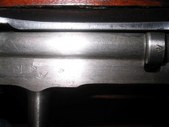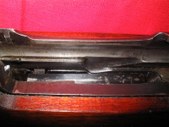
1
Full length view of rifle and bayonet.
| 
2
Receiver markings. Note there are no refurb markings (square with slash(es) through it).
| 
3
The Finnish capture mark, SA.
| 
4
Matching floorplate - note the fnt matches all other s/n stamps on the rifle.
|

5
View of action.
| 
6
Matching buttplate. Note the Izhevsk factory stamp as well.
| 
7
Another view of the buttplate markings.
| 
8
Buttstock. Note the correct pre-war screwed-in sling slot escutcheons. The Russian involvement in WW2 began in June 1941.
|

9
View of rear sight area. Note that there are no transverse pins through the site base. A refurbed 1941 would have these two transverse pins which Izhevsk only started using at the factory in late 1941 at the earliest. Tula never used them and all Tulas with these pins are refurbs. Also note the early use of rear band dish cuts - uncommon on a 1941 made rifle.
| 
10
Rear band.
| 
11
Muzzle area. Note this rifle has milled band springs. Correct for 1941.
| 
12
Izhevsk markings on magazine body.
|

13
Stamps in the stock grip area. They are production markings. the stock is unsanded and retains original shellac finish.
| 
14
Additional inspection stamps in the stock wood.
| 
15
Note the original Izhevsk procution roundel. It is not deeply struck, but remains unsanded. It consists of a hammer & sicle surrounded by a wreath and an outer ring with CCCP stamped into it.
| 
16
Anotehr stock inspector's stamp.
|

17
Rear sight with early deep notch mill mark. Note the Izhevsk arrow-in-triangle maker's stamp.
| 
18
Production stamps on the bolt body.
| 
19
Izhevsk stamp on cocking piece.
| 
20
Note the early production large diameter cocking piece flange milled at the bottom to clear the tang like on an M91. Not long after this rifle was produced the wartime smaller diameter flange was phased into production.
|

21
Note the bolt head and hte Izhevsk marked extractor.
| 
22
Open view of action.
| 
23
Full length view of the rifle.
| 
24
View of muzzle. Note the brass end caps on the handguard.
|

25
Note the screwed in escutcheons.
| 
26
Another view of the rear sight base.
| 
27
View of action with open bolt.
| 
28
Buttstock.
|

29
Buttplate. One of the few areas on this rifle that shows significant wear. Likely the soldier issued this rifle often planted the butt onto the ground.
| 
30
Tang stamp, showing a receiver production date of 1941.
| 
31
Floorplate and follower, removed from the rifle.
| |

